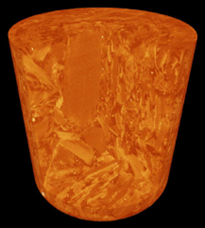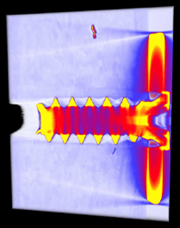Experimentelle Charakterisierung und modellbasierte Beschreibung des Ein- und Überdrehmoments sowie des Auszugversagens von Schrauben im Möbelbau
| Doktorand / Doktorandin | Michael Auernheimer |
|---|---|
| Forschungsschwerpunkt | Bioökonomie und Holztechnologie |
| Zeitraum | 01.10.2020 - 31.12.2028 |
| Wissenschaftlich betreuende Person THRO | Prof. Thorsten Ober |
| Einrichtung | Fakultät für Holztechnik und Bau |
| Wissenschaftlich betreuende Person (extern) | Universität Innsbruck | Prof. Dr.techn. Roman Lackner |
Einsatz des am NanoLabs der Universität Innsbruck verfügbaren Röntgenmikroskops: (links) Holzprobe mit Schraube im Probenraum, (Mitte) Charakterisierung der Mikrostruktur des Holzwerkstoffs und (rechts) Verformungssituation im eingeschraubten Zustand (Euroschraube mit Unterlegscheibe)
Use of the X-ray microscope available at the NanoLab of the University of Innsbruck: (left) wood sample with screw in the sample chamber, (centre) characterisation of the microstructure of the wood-based material and (right) deformation situation in screwed-in state (Euro screw with washer)
Detaillierte Kenntnisse über Schraubverbindungen und die damit einhergehende Nutzung von speziellem Werkzeug wie Drehmomentschlüsseln oder -schraubern, sind heute in vielen Industrien elementar. Dabei bildet die Holzindustrie, insbesondere die Möbelbranche, aufgrund stark variierender Eigenschaften der zusammenwirkenden Materialien, eine Ausnahme.
Um das Verständnis zum Einfluss von Holzeigenschaften und Einschraubparametern auf Ein- und Überdrehmoment sowie der Ausziehkraft zu verbessern und langfristig auch den Qualitätsstandard von Möbeln, insbesondere der verschraubten Bauteile, zu erhöhen, ist das Ziel der Promotion, Methoden zur experimentellen Charakterisierung und Analyse der Mikrostruktur von Holzwerkstoffplatten, sowohl im unbelasteten Zustand als auch unter Berücksichtigung von Veränderungen durch eingebrachte Schrauben, zu entwickeln. Auf Grundlage dieser Methoden soll der Einfluss der wesentlichen Material- und Montageparameter auf Überdrehmoment und Auszugskraft bestimmt und bewertet werden, um daraus die Parameter für eine optimale Montage zu definieren. Außerdem soll ein modellbasiertes Verständnis zur Materialmikrostruktur und ihrer Entstehung im Zuge der Herstellung bzw. der Belastung im Zuge des Eindrehens und der Belastung von Schrauben geschaffen werden. Zudem wird sollen modellbasierte Korrelationen zur Abbildung des Ein- und Überdrehmoments sowie der Ausziehkraft entwickelt werden.
Detailed knowledge of screw connections and the associated use of special tools such as torque levers or screwdrivers are essential in many industries today. The wood industry, especially the furniture industry, is an exception due to the widely varying properties of the interacting materials.
In order to improve the understanding of the influence of wood properties and screw-in parameters on screw-in and over-torque as well as withdrawal force and, in the long term, to increase the quality standard of furniture, especially of the screwed components, the aim of the dissertation is to develop methods for the experimental characterisation and analysis of the microstructure of wood-based panels, both in the unloaded state and taking into account changes caused by inserted screws. Based on these methods, the influence of the essential material and assembly parameters on overtorque and withdrawal force is to be determined and evaluated in order to define the parameters for optimal assembly. In addition, a model-based understanding of the material microstructure and its formation in the course of production or the load in the course of screwing in and loading of screws is to be created. In addition, model-based correlations will be developed to map the screw-in and over-torque as well as the extraction force.


